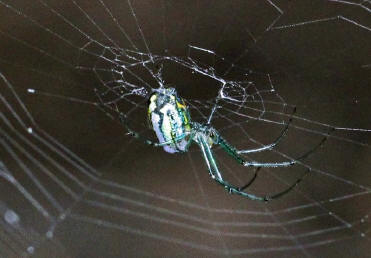 Now that we are coming to the end of the summer we are going to be seeing some of the gardenerís best friends among our bushes. Following the usual prey-predator cycle during the past couple of months insect numbers have been steadily increasing. By August
more of the grasshoppers and night- flying moths are active. Now the more colorful and showy members of the predator class begin to make their appearance. These are the larger garden and barn spiders that spin their elegant orb webs in our gardens and around our houses.
Now that we are coming to the end of the summer we are going to be seeing some of the gardenerís best friends among our bushes. Following the usual prey-predator cycle during the past couple of months insect numbers have been steadily increasing. By August
more of the grasshoppers and night- flying moths are active. Now the more colorful and showy members of the predator class begin to make their appearance. These are the larger garden and barn spiders that spin their elegant orb webs in our gardens and around our houses.
Gardeners realize that the spider is one of many of natureís greatest helps in keeping the number of pests manageable.
Their unobtrusive hoards have been silently patrolling our gardens and lawns all summer, keeping the number of insects in check. Perhaps you have seen the colorful crab spider sitting camouflaged in a flower waiting to ambush an unsuspected arrival. Or you might have encountered the dark brown wolf spider, often with and egg sac on her back, running along the ground or
through the weeds. Given her size, you canít miss her. Her name is well deserved as she captures her prey on the run. And everyone has encountered my personal favorite, the jumping spider. These are often seen running along the bricks or windowsill of our house, or on the porch railing, in the heat of the day. They frequently sport iridescent colors, blue-greens, reds,
yellows and white. They have excellent eye-sight and can see as far as 8 inches. This enables them to sneak up on an unsuspecting fly and jump on it unawares, hence the name.
The spiders you see are usually the females. Male spiders are usually many magnitudes of size smaller than their consort. For most species they are very hard to see. They have been working all summer, too, and are now on the prowl for a mate. So when you do see a female in her large orb web, look down at the lower edge and see if one or more tiny males arenít hanging
around. They are plucking the strands and when they get the chance they will approach the female and mate.
|

The Orchard Spider, Leucauge venusta , can be seen in
a variety of habitats including orchards (hence the name), hardwood forests, hammocks, the edge of woodlands
and shrub-filled meadows.
|
If you are fortunate, you will have one of the large black and yellow garden spiders. They spin a large orb-shaped web that spans a good distance. Some species mark the center of the web with an X-shaped pattern of webbing. This is called a stabilimentum. Some believe it is to help birds avoid hitting the web as they fly during the day. As it reflects ultraviolet light
it may also attract some insects.
Another large orb-weaver is the barn spider. These will become more prevalent as we approach Halloween. This spider is less showy in appearance. She is varying shades of brown. If you look closely her back has a very ornate pattern of triangles and stripes. Since this spider often makes her web near our houses, go out in the evening and, if you are lucky, you might be
able to observe her spinning her web. This engineering feat requires several different types of silk spun from her six spinnerets. The strongest ones form the frame, the spokes follow, and then she spins the spiral lateral rungs of the ladder. As these last are laid down, she deposits a sticky substance on them. A quick pluck with her hind leg distributes it in regular
droplets along the string. Yet, she can run with incredible speed in the web without getting stuck!
You will also see the small orchard spider in her web that looks like an inverted bowl. She is predominantly silver with multicolored flecks. She will be making eggs now and you might see them hanging near the nest.
Protecting your lawn you will see the funnel-shaped nests of the grass spider. She is often in the entrance to the funnel waiting to run out and snare a hapless victim. Look above the sheet and you will see a complex tangle of fine threads. These help interrupt the flight of insects and force them down into the sheet to become dinner.
So take the time to enjoy the handiwork of some of natureís most amazing engineers.
Read other articles on birds, wildlife & beneficial insects
Read other articles by Phillip Peters